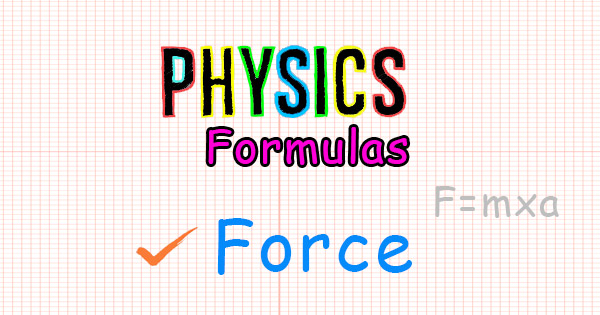
When one comes across the word Force they get an idea of getting energized. We continuously encounter the term push and pull associated to it. So what precisely is this Force?
In brief Force can be described as the exterior agency which makes the body change its state, size, position under strain. It is represented by F.
Commonly, the formula for force is articulated by
F = m × a
Where,
m = mass
a = acceleration.
It is articulated in Newton (N) or Kgm/s2.
Acceleration a is given by
a = v/t
Where v = Velocity and
t = time taken
So Force can be articulated as
F = mv/t
Inertia formula is termed as p = mv which can also be articulated as Momentum
Therefore, Force can be articulated as the rate of change of momentum.
F = p/t = dp/dt
Force formulas are beneficial in finding out the force, mass, acceleration, momentum, velocity in any given problem.
Check the list of all Physics Formulas here. For Biology, Physics, Maths, English, GK etc please check respective sections of CheckAll.in. You can now subscribe here for free, to get notification regarding new posts.
Here are some exercise problems with solutions for you.
Solved Problems using Force Formula
Problem 1: David has a toy car of mass 5kg. How much force should he apply on the car so that it should travel with the acceleration of 10m/s2?
Answer:
Known:
m (Mass of toy car) = 5 Kg,
a (Acceleration) = 10m/s2,
F is Force to be applied by David = m × a
= 5 Kg × 10 m/s2 = 50 Kgm/s2 = 50 N.
Problem 2: A hammer having a mass of 2.5 kg going with a speed of 10 m/s hits a wall and comes to rest in 0.2 sec. Compute the obstacle force that makes the hammer stop?
Answer:
Given: Mass of Hammer, m = 2.5 kg
Initial Velocity, u = 10 m/s,
Final Velocity, v = 0 m/s,
Time Taken, t = 0.2 s.
The acceleration is, a = (v – u)/t
Therefore, a = -50 m/s2 [-ve sign indicates retardation]
Thus the retarding Force, F = ma = 2.5 × 50 = 125N
Problem 3: An object resting on a table. Mass of the object is 1 kg. Acceleration of gravity is 9.8 m/s2. Determine the normal force exerted on the object by the table.
Answer:
Known,
Mass (m) = 1 kg
Acceleration of gravity (g) = 9.8 m/s2
Weight (w) = m g = (1 kg)(9.8 m/s2) = 9.8 kg m/s2 = 9.8 Newton
Wanted: normal force (N)
N – w = 0
N = w
N = m g
N = 9.8 Newton
So the normal force on the object, exerted by the table is 9.8 N upward.